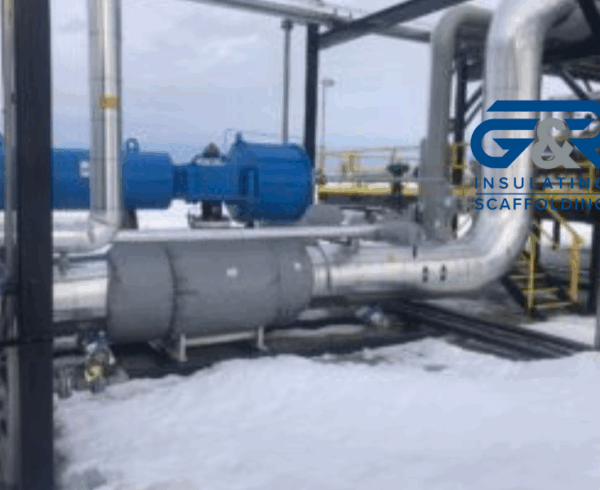Pipes help carry hot or cold liquids where they need to go. But did you know that unwrapped pipes can cause problems? They can freeze, leak, or waste energy. That’s where pipe insulation wrap comes in. It protects your pipes and helps them last longer.
In this blog, we will talk about why pipe insulation wrap is important. We’ll explain how it works, when to use it, and how a good service, like G & R Insulating, can help. Let’s get started!
What Is Pipe Insulation Wrap?
Pipe insulation wrap is a soft or firm cover that wraps around pipes. It helps keep heat in and cold out. It also keeps water inside the pipe from freezing during cold months.
There are different types of insulation wraps. Some are made from foam, fiberglass, or rubber. Some wraps are soft and bend easily. Others are thick and stiff. The type you need depends on your pipe and the job it does.
Why it Matters:
- Keeps water pipes from freezing and bursting
- Saves energy by holding heat inside hot water pipes
- Reduces moisture and prevents pipe rust
- Makes buildings safer and more energy efficient
Where Should You Use Pipe Insulation Wrap?
Not all pipes need insulation. But many do, especially in cold places or around hot water systems.
Here are common places where you should use pipe wrap:
- Basements or crawl spaces: These areas get cold and damp. Wrapping pipes here prevents freezing.
- Outside walls: Pipes near the outside of your home or building lose heat faster.
- Garages or sheds: These spaces are often unheated.
- Hot water lines: Insulating them keeps your water hot for longer.
- Commercial buildings: Big buildings have long pipe systems. Wrap helps save energy and keep systems safe.
Fact: Even if you live in a warm area, pipe insulation still helps! It prevents heat loss and saves money on water heating.
Pipe Insulation Wrap Service Cost
The cost of pipe insulation wrap services can vary depending on several factors:
-
Pipe length and diameter: Longer and wider pipes require more material and time.
-
Type of insulation material used: Fiberglass, foam, and rubber have different prices. For example, fiberglass tends to be more costly but works better in extreme heat.
-
Location and accessibility: Pipes in hard-to-reach places (like crawlspaces or ceilings) may cost more to insulate due to the extra labor involved.
-
Pipe insulation wrap costs range: From $200–$600 for small jobs to $1,000+ for large commercial projects. Get expert service with G & R Insulating.
G & R Insulating provides free consultations and quotes, so you’ll always know what to expect. Their team considers all the above factors and offers competitive, transparent pricing tailored to your project’s needs.
Benefits of Professional Pipe Insulation Services
You can buy pipe wrap at a hardware store. But doing the job right takes skill. That’s why many people choose professional services like G & R Insulating.
Here’s why professional help is important:
a. Proper Materials
Experts know which type of wrap works best. For example, fiberglass wrap is great for very hot pipes. But it must be installed carefully.
b. Safe Installation
Installing wrap may seem easy, but it can be risky. If you work near gas lines or electrical systems, it can be dangerous. Trained workers know how to stay safe.
c. Saves Time and Money
Doing it yourself may lead to mistakes. Poor wrapping can still cause pipes to freeze or leak. That means repairs later. A good job done once saves you money.
d. Better Results
Professional insulation looks clean and lasts longer. It also works better. Experts make sure every pipe is covered the right way.
Why G & R Insulating Is a Trusted Name
G & R Insulating is known for doing the job right. They have trained staff and use strong, safe materials.
Here are some of the services they offer:
- Mechanical piping insulation: Covers all sizes and types of pipes
- Glycol tubing installation: Great for heating systems
- Vessel and tank insulation: Protects large containers from heat loss
- Oilfield buildings: Keeps workspaces warm and energy efficient
- Utilidors and insulated blankets: More options to keep systems running well
- Scaffolding services: Helps workers reach high or hard-to-get areas
All of these services help protect your property and save energy. G & R Insulating makes safety a top priority too. Their workers are trained to follow safe steps on every job.
Conclusion
Wrapping your pipes may seem like a small job, but it makes a big difference. Pipe insulation wrap helps protect pipes, saves energy, and lowers repair costs. Whether for a home or business, it’s a smart choice. When done by trained experts, like those at G & R Insulating, the results are even better. They use strong materials, work safely, and make sure your system runs right.
Providing quality service and safe, strong products is key. G & R Insulating ensures their staff is trained and ready to handle each job with care. They offer more than just pipe insulation—they offer peace of mind. Contact us today to learn more about pipe insulation and how it can help your home or business stay safe and efficient!
















